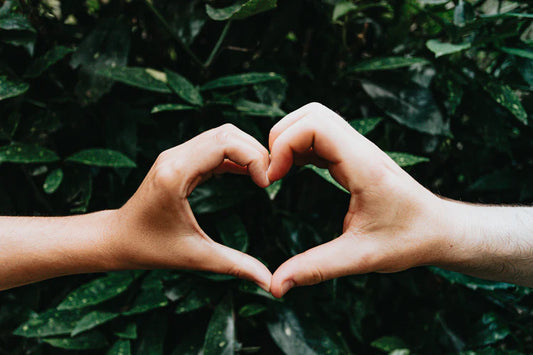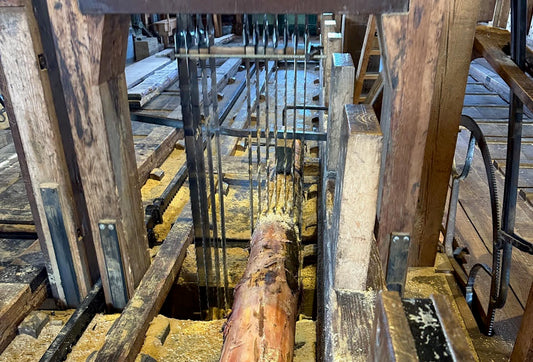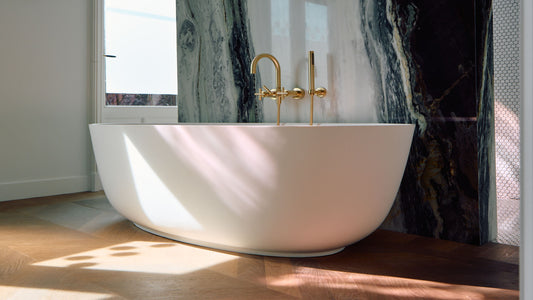Vloeren

Datum: 16 augustus 2023
Leestijd: 6 minuten
Auteur: Uipkes Houten Vloeren
The Evolution of Floors in Interiors: From Functional to Artistic Masterpiece
The floor is an essential and often overlooked element of any interior design. Not only is it a functional surface to walk on, but it also has a significant impact on the aesthetics and overall atmosphere of a room. The evolution of floor design in interiors is a fascinating journey through time, where functionality, aesthetics and technological advancement come together to create true masterpieces.
Bezoek de showrooms
The Primitive Principles: Functionality and Materials
In the earliest human settlements, the floor was nothing more than packed earth, stones or animal skins. Functionality was key: the floor had to provide protection against the elements and be a sturdy surface to live on. As civilization developed, people began experimenting with materials such as clay, wood and stone to make their floors more durable. These primitive floors mainly served a practical purpose and paid little attention to aesthetics.
The Rise of Aesthetics: Patterns and Carpets
With the rise of more advanced cultures, new possibilities for floor design emerged. In ancient civilizations such as the Greeks, Romans and Persians, patterns and carpets began to adorn the floor. Carpets were woven by hand and often decorated with complex designs and colors that reflected the status and wealth of the owner. This began the symbiosis between functionality and aesthetics on the floor.
Technological Advances And Diversification Of Materials
With the rise of technological advancements in the Industrial Revolution, new materials and manufacturing methods were introduced to the world of flooring design. Wooden floors became popular and began to vary in patterns, from herringbone to parquet . Tiles of ceramic, marble and other materials were introduced, allowing floors to be decorated with intricate mosaics. This period of development laid the foundation for a wider range of design possibilities.
Modern Age: Creative Expression and Sustainability
In modern times, the floor has transformed from a purely functional element to a canvas for creative expression. Floors are now considered an integral part of the overall interior design. There are an abundance of materials available, ranging from traditional wood and tile to more modern choices such as concrete, vinyl and even recycled materials.
Sustainability has also played an important role in the evolution of flooring design. Environmentally conscious choices such as bamboo and recycled wood are gaining popularity, while innovative technologies such as underfloor heating improve comfort and efficiency.
The Future of Floor Design: Merging Technology and Art
The future of floor design promises even more innovation and groundbreaking concepts. With the rise of digital technologies, floors can now be printed with a wide range of images, patterns and colours. Interactive floors that respond to movement and touch are becoming increasingly popular in commercial and residential spaces, creating a playful and unique experience.
Moreover, sustainability and environmental awareness will play an even greater role. Materials that have little impact on the environment and recycled raw materials will be of paramount importance.
SWOT Analysis Types of Floors
Below is a description of the strengths, weaknesses, opportunities and threats for popular types of floors per floor.
Wooden floors:
- Strengths: Warm and cozy appearance, durability (depending on wood specie ), timeless appeal, can be sanded and refinished.
- Weaknesses: Sensitive to scratches and dents and temperature fluctuations, may require more frequent maintenance.
- Opportunities: Wide variety of wood species and finishes, can be adapted to different styles.
- Threats: High costs for certain wood species , potential negative impact on the environment if the wood is not harvested sustainably.
Tiled floors (Ceramic/Porcelain)
- Strengths: Durable and resistant to moisture, easy to clean, wide choice of colors and patterns.
- Weaknesses: Cold to the touch, hard surfaces can be uncomfortable to stand on for long periods of time, grout lines can collect dirt and stains.
- Opportunities: Great variety in designs, can be used in both classic and modern interiors.
- Threats: Fracture due to heavy impact, slippery in wet conditions.
Carpet floors
- Strengths: Warm and soft, dampens sound, comes in different colors and textures, comfortable to walk or sit on.
- Weaknesses: Can retain stains and dirt, less durable than other floor types, requires regular vacuuming.
- Opportunities: Various patterns and styles, can create a cozy atmosphere.
- Threats: Allergens can build up in carpets, making them more difficult to clean if severely stained.
Laminate floors
- Strengths: Affordable alternative to wooden floors, durable and resistant to scratches, easy to install.
- Weaknesses: Cannot be sanded, less authentic appearance than real wood, can be damaged by moisture.
- Opportunities: Wide range of patterns and finishes, imitating natural materials.
- Threats: Limited lifespan compared to other flooring materials, can be prone to wear and tear with heavy use.
Concrete Floors
- Strengths: Modern and industrial appearance, durability, can be polished for a glossy finish, suitable for underfloor heating .
- Weaknesses: Hard and cold surface, prone to staining if not properly sealed.
- Opportunities: Minimalist appearance, versatile in design options.
- Threats: More difficult to install or repair than some other flooring materials.
Vinyl Floors
- Strengths: Affordable, water-resistant, sound-absorbing, easy to maintain, available in different patterns and colors.
- Weaknesses: Can be damaged by sharp objects, less durable than some other flooring materials, may feel slightly synthetic.
- Opportunities: Realistic imitations of wood, stone and tiles, suitable for damp areas.
- Threats: Cheaper vinyl types may fade or wear out over time.
Natural Stone Floors (Marble, Granite, Slate)
- Strengths: Unique natural appearance, durability (depending on the type of stone), timeless character.
- Weaknesses: Expensive to purchase and install, requires regular maintenance and sealing, can be cold to the touch.
- Opportunities: Wide variety of colors and patterns, creates a luxurious atmosphere.
- Threats: Sensitivity to stains and scratches, may become slippery when wet.
Cork Floors
- Strengths: Environmentally friendly, warm and comfortable to the touch, dampens sound, natural texture.
- Weaknesses: Sensitive to dents and scratches, may discolour when exposed to direct sunlight.
- Opportunities: Sustainable harvesting process, can be applied in different styles.
- Threats: Requires regular sealing to maintain moisture resistance, limited variety in colors and patterns.
Bamboo Floors
- Strengths: Durable and renewable, comparable to hardwood, unique appearance, environmentally friendly.
- Weaknesses: Sensitive to scratches, limited color choice, may discolor over time.
- Opportunities: Fast growth of bamboo makes it ecologically sound, modern and contemporary in appearance.
- Threats: Quality may vary depending on manufacturer, sensitive to moisture.
Rubber Floors
- Strengths:Durable and resilient, sound-absorbing, comfortable to walk on, suitable for commercial spaces.
- Weaknesses: Limited aesthetic variety, may have an industrial appearance.
- Opportunities: Versatile in colors and patterns, ideal for gyms and play areas.
- Threats: May be prone to staining, may discolour with prolonged exposure to sunlight.
Flooring trends
Sustainability And Environmental Friendliness:
Sustainability has become an important trend in floor design. People are increasingly aware of the impact of their choices on the environment, which is why flooring materials that are environmentally friendly and sustainably produced are becoming increasingly popular. This includes materials such as recycled wood, bamboo, cork and recycled rubber. Attention is also paid to the sustainability of the production processes and the lifespan of the floors.
Wood look tiles
This trend combines the warmth and appearance of wood with the durability and convenience of tiles. Wood look tiles are ceramic or porcelain tiles printed with a realistic wood grain pattern. They are available in different wood species and colors and can be used both indoors and outdoors. These tiles offer the aesthetics of wood with the durability of tiles.
Concrete look floors
Concrete look floors are gaining popularity because of their modern and industrial look. They can be realized with real polished concrete or with concrete-like ceramic tiles. Concrete look floors fit well with minimalist and contemporary interior styles and provide a sleek and understated backdrop for other decorative elements.
Pattern tiles
Floor tiles with striking patterns and mosaics are a recurring trend. These tiles add an artistic element to a room and can be used to create a focal point. They are available in a wide range of designs, from classic to modern patterns, and can be used in kitchens, bathrooms and even living areas.
Wide Planks
In wooden floor design, wide planks have become popular. These wider planks create a more spacious and modern feeling. They can vary in wood species and finishes, making them suitable for both traditional and contemporary interior styles.
Light And Neutral Colors
Modern digital printing technology makes it possible to create floor tiles with realistic reproductions of different materials, such as wood, marble and natural stone. This opens the door to more affordable options that can still mimic the aesthetics of luxury materials.
Digital Printing Technology
Light and neutral colors are an ongoing trend in floor design. They create a more spacious feeling and provide a timeless backdrop for different furnishing styles. White , beige, light gray and soft earth tones are often chosen colors for modern floors.
Interactive Floors
These floors represent an exciting and innovative development in floor design. Interactive floors are designed to respond to movement, touch or pressure, providing an interactive and engaging experience for users.
These floors are often used in commercial spaces, public places, educational environments and sometimes even in homes. Here are some examples of interactive floors and their applications
Motion Sensitive Floors
These floors respond to the movements of people walking over them. This can range from activating lighting effects to producing sounds or visual patterns. They are often used in children's play areas, interactive art installations and events.
Virtual Games And Simulations
Interactive floors can be integrated into virtual games and simulations. This can range from dancing games where players dance on the floor to score points to educational games that teach children about science, math and other subjects.
Marketing And Advertising
Companies use interactive floors as creative marketing tools to attract customer attention. For example, shopping centers can use interactive floors to engage and encourage passersby to visit their stores.
Sensory Therapy And Education
In therapeutic environments, interactive floors can be used to provide sensory stimulation for people with special needs. They can also be used in education to create interactive and engaging learning experiences.
Resume
Evolution of Floor Design: From Functional to Artistic Masterpiece
The evolution of floor design in interiors is a fascinating journey through time, where functionality and aesthetics come together. From the primitive earth and animal skins to modern innovations, the floor has evolved into a crucial element that provides both comfort and style. Ancient cultures introduced patterns and rugs, while the Industrial Revolution brought new materials and design options.
Analysis of Floor Types:
Each floor type has unique strengths, weaknesses, opportunities and threats (SWOT). Wooden floors radiate heat but are sensitive to scratches. Tiles are durable but can be cold. Carpet is comfortable but requires maintenance. Laminate is affordable but cannot be sanded. Concrete is modern but hard. Vinyl is versatile but can be damaged. Natural stone is unique but expensive. Cork is environmentally friendly but can get dented. Bamboo is renewable but can be scratched. Rubber is resilient but can feel industrial.
Trends in Floor Design:
Trends in floor design reflect contemporary values and aesthetics. Sustainability and environmental friendliness are prominent, with materials such as recycled wood and cork on the rise. Wood look tiles combine warmth and durability. Concrete look floors offer a modern industrial look. Patterned tiles add artistic elements. Wide planks and light colors create space. Digital printing technology imitates luxury materials affordably.
At its core, the story of flooring shows a constant search for balance between practicality and aesthetic excellence. It reflects the human need for comfort, expression and sustainability within our living environments.
Showroombezoek
Ben je op zoek naar een vloer van hout, bezoek een van onze showrooms en ervaar duurzame houten vloeren. De vloeren zijn verkrijgbaar in 17 patronen en 90 maatwerk kleuren.
Frequently Asked Questions
What are the most sustainable floors for consumers?
Sustainable flooring choices include (recycled) wood, bamboo, cork and floors made from recycled materials such as rubber. At the same time, it is important to pay attention to certifications such as FSC for wood and FloorScore for indoor air quality.
Which floor type is most suitable for damp areas such as bathrooms?
Tiles, especially ceramic or porcelain tiles, are ideal for damp areas because of their water resistance and durability. Concrete look tiles can also be suitable for a modern and sleek look.
Which floor is best for a modern interior with an industrial feel?
Concrete look floors go well with modern furnishings with an industrial feel. They offer a minimalist and sleek look that fits well with this style.
Are carpet floors suitable for people with allergies?
Carpet floors can trap allergens such as dust and dust mites, which can make them less suitable for people with severe allergies. Allergy sufferers may consider choosing floors that are easy to clean and hold fewer allergens, such as wood, tile or laminate.
What are some innovative technologies in modern flooring?
Interactive floors that respond to movement, smart underfloor heating systems that promote energy efficiency and digital printing technology that allows floors to mimic realistic patterns and textures are among the innovative technologies used in modern floor designs.
Stay up to date with news about floors and interior





